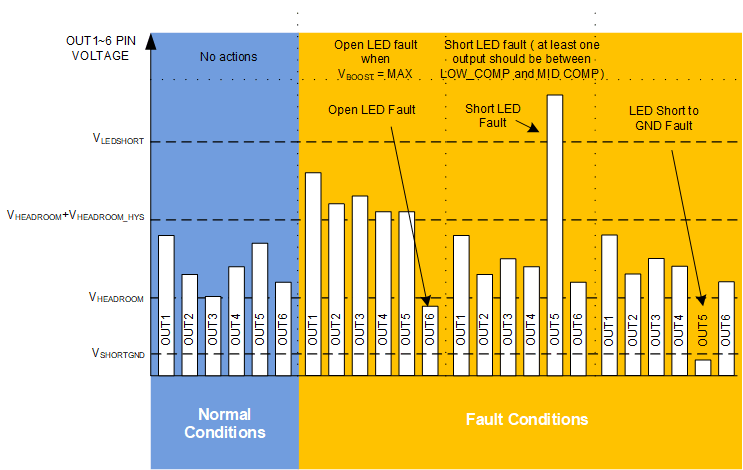SNVA966 July 2020 – MONTH LP8864-Q1 , LP8864S-Q1 , LP8866-Q1 , LP8866S-Q1
- Trademarks
- 1Fault Handling Routine
- 2Different Fault and Diagnostic Handling Method Recommendation
- 3Summary
-
A Fault-Related
Functions
-
A.1 Protection and Fault Detections
- A.1.1 Supply Faults
-
A.1.2 Boost Faults
- A.1.2.1 Boost Overvoltage Faults (BSTOVPL, BSTOVPH)
- A.1.2.2 Boost Overcurrent Faults (BSTOCP)
- A.1.2.3 LEDSET Resistor Missing Faults (LEDSET)
- A.1.2.4 MODE Resistor Missing Faults (MODESEL)
- A.1.2.5 FSET Resistor Missing Faults (FSET)
- A.1.2.6 ISET Resistor Out of Range Faults (ISET)
- A.1.2.7 Thermal Shutdown Faults (TSD)
- A.1.3 LED Faults
- A.1.4 Overview of the Fault and Protection Schemes
- A.2 Programming Examples
-
A.1 Protection and Fault Detections
A.1.3.1 Open LED Faults (OPEN_LED)
During normal boost operation, boost voltage is raised if any of the used LED outputs falls below the LED_DRV_HEADROOM threshold level. Open LED fault is detected if boost output voltage has reached the maximum and at least one LED output is still below the threshold. The open string is then disconnected from the boost adaptive control loop and its output is disabled. Any LED fault sets the status bit LED_STATUS and an interrupt is generated unless LED interrupt is disabled. The detail of open LED faults can be read from bits OPEN_LED and LEDx_FAULT (x = 1...4 (LP8864-Q1 & LP8864S-Q1)/ 6 (LP8866-Q1 & LP8866S-Q1)), indicating the faulty LED) in LED_FAULT_STATUS register. These bits maintain their value until device power-down while the LED_STATUS bit is cleared by the interrupt clearing procedure. If a new LED fault is detected, LED_STATUS is set and an interrupt generated again.
 Figure 4-3 LED Open and Short Detection Logic
Figure 4-3 LED Open and Short Detection Logic